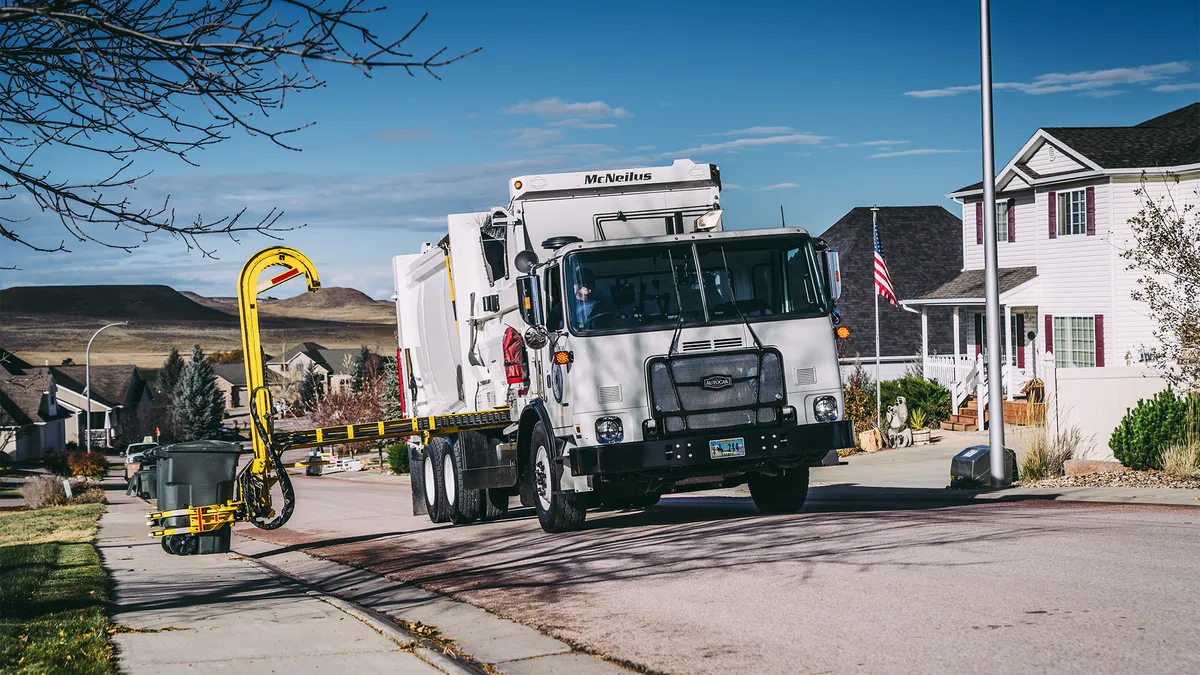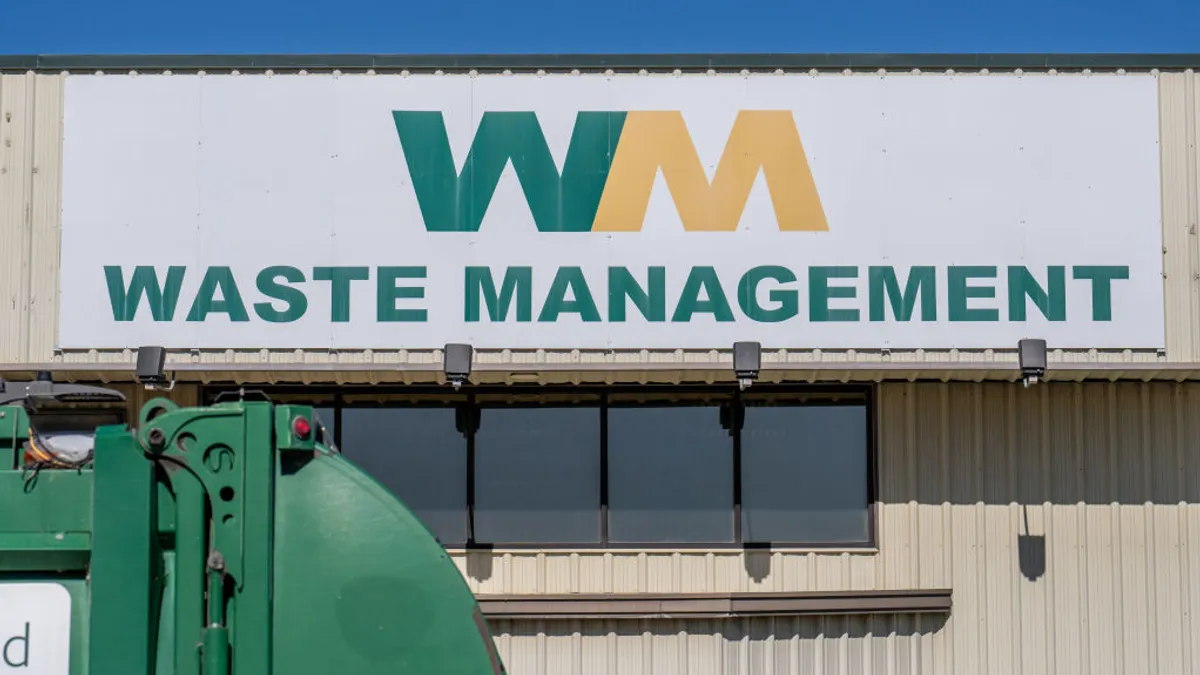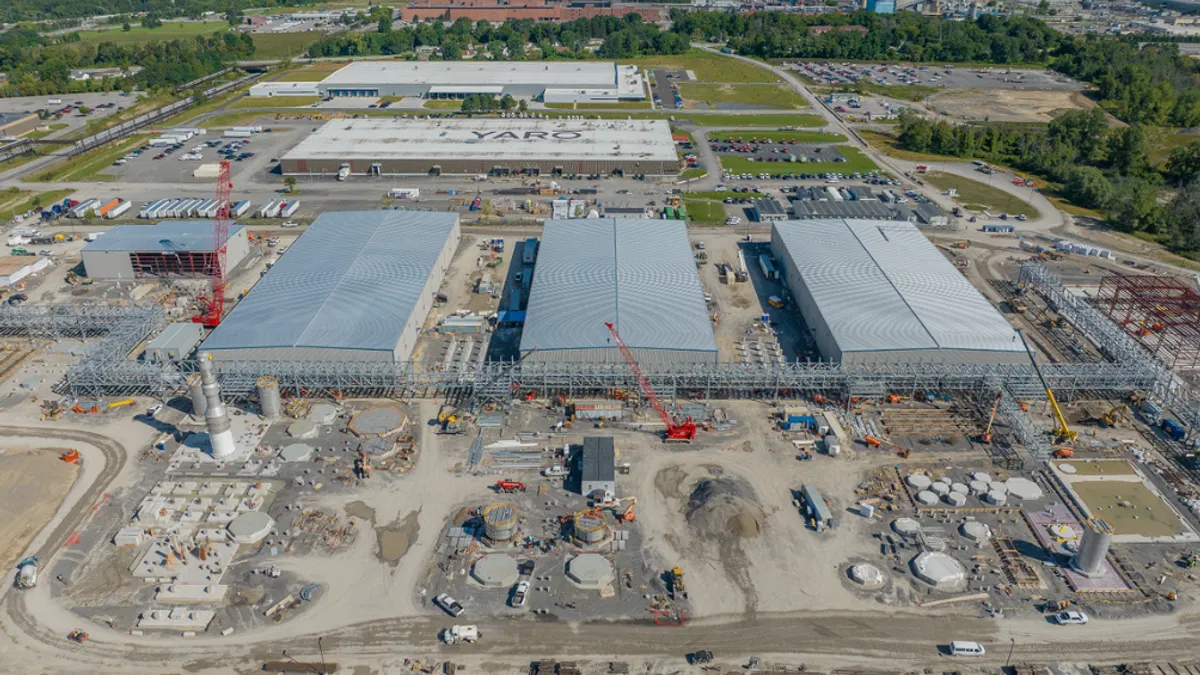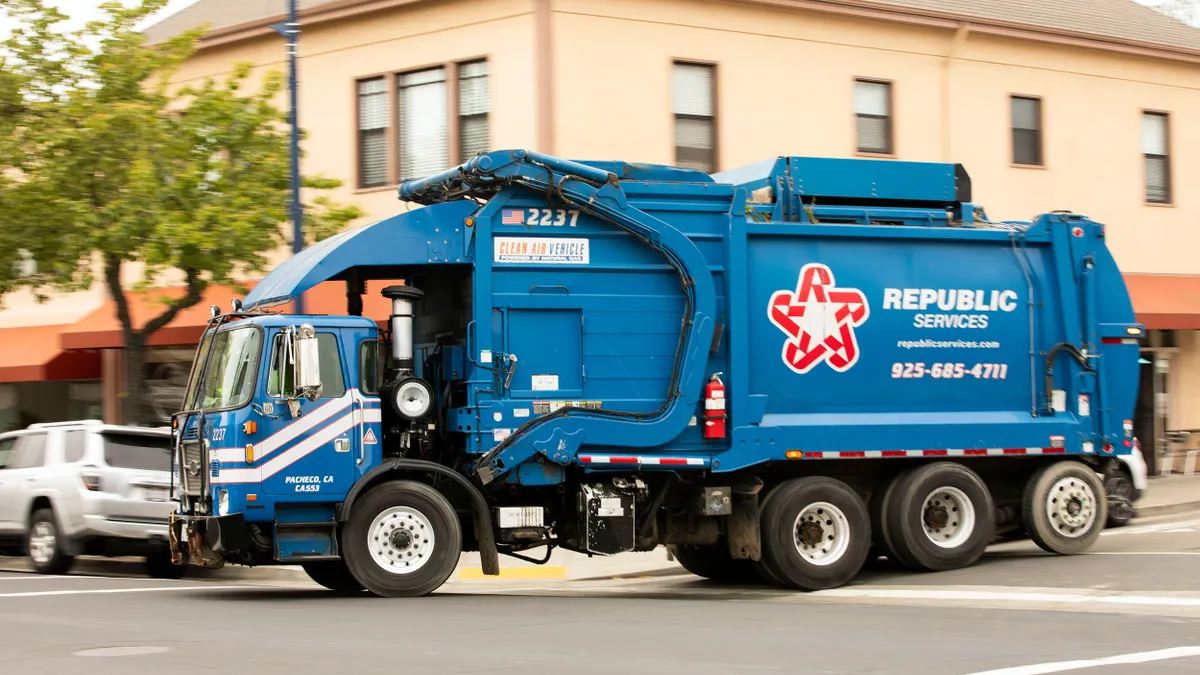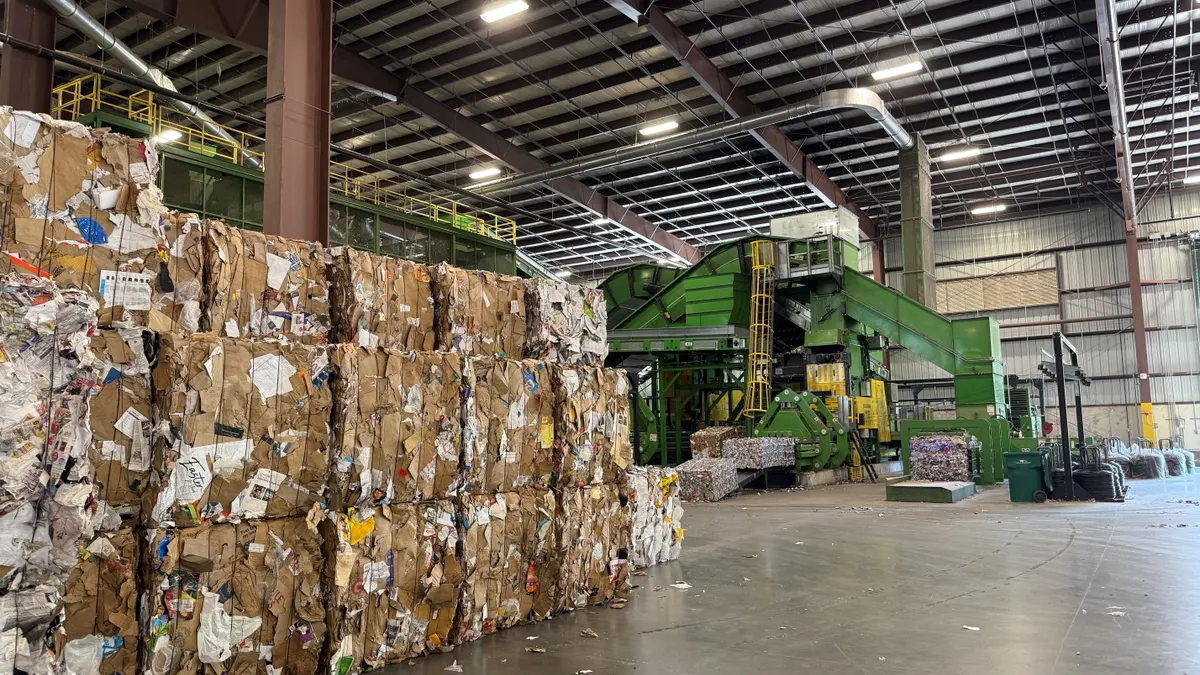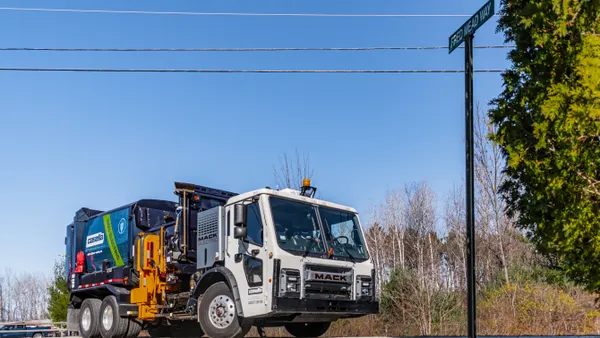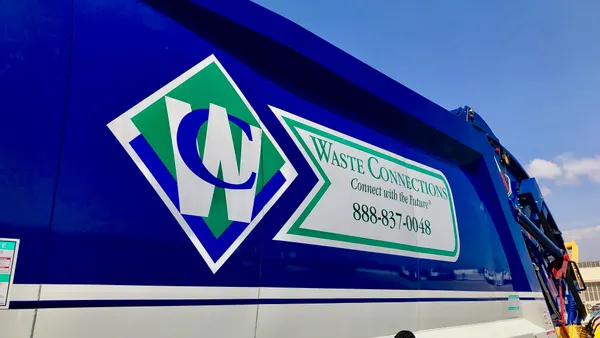Dubuque, Iowa has done all it can to maximize the benefits of a new automated side loader — even mapping out the location of each ASL-friendly cart to optimize the collection route — before the truck rolls down streets for the first time in spring 2021. But the vehicle will bring another advantage city officials didn’t anticipate: The drivers will stay more isolated from any possible coronavirus exposure outside the cab.
Though the city started planning for ASL collection five years ago, pandemics can force municipalities to reassess operations. “With COVID, it really made us look at, well, how are we really doing this?” John Klostermann, Dubuque’s public works director told Waste Dive. “How does it affect our workforce?”
Haulers would be safest in a pandemic if they never contact trash or people — a precaution automated side loaders offer – based on public health guidance. That safety benefit magnifies the appeal of machinery, which was already gaining traction in part because it insulates operators from on-the-job injuries, according to customers and vendors. While pandemic-decimated municipal budgets and tighter capital spending among the private sector might slow investment in ASL vehicles, interest still remains and many expect the trend to continue long term.
Watching an automated side loader in action feels like seeing kids master the claw arcade game and winning a teddy bear. When pulled up to the right spot, a mechanical arm creeps out from the truck to pinch, lift and flip carts until all the trash, recycling or organics empty out. Drivers stay inside the entire time — a benefit for a line of work where employees often still get injured lifting waste or being hit by vehicles. That latter issue continues to make collection one of the deadliest jobs in the U.S. with 36 North American workers dying on the job in 2019, according to the Solid Waste Association of North America.
Adapting to ASLs
The automated arm works best with carts of specific dimensions, placed at the curb in a standard format. And as Bangor, Maine transitions to ASL vehicles, the city government dropped off those standardized carts and educating residents on what collection day must look like for this new method to be a success.
“We had multiple public meetings, we had demonstrations, we had so much PR, but people sometimes just miss it until it's actually being placed in front of their home,” said Gretchen Schaefer, the Bangor city councilor who chairs the infrastructure committee and answered a flood of last-minute questions from locals.
General confusion aside, Schaefer still thinks the new trucks will make the hassle worthwhile. Not only will they hopefully cut down on workplace fatalities — a garbage truck fatally struck one collection worker in the area last year — but the new contract with Casella Waste Systems is also easier on Bangor's budget.
The city will spend $35,000 less on waste services in the first year, with more cost reductions in the future. Some of those savings might also come from fewer workers’ compensation payouts as fewer people get injured on the job, Casella told the city. ASL vehicles also typically cut back on overall labor costs because the trucks need fewer people to operate. The council was concerned the new trucks might mean fewer jobs in the area, but Casella told the city it was struggling to find employees in the first place, Schaefer said.
She also hopes the bins will help keep streets clean. Instead of trash heaps on the curbs that dogs and crows can get into, residents will have the 32- or 96-gallon carts to contain the waste. To prove to skeptical taxpayers the containers are big enough, Schaefer took photos of her 5’4” self next to the carts, which came up to her neck.
Residents had other concerns. Some locals didn’t like the idea of rolling their carts across the street on pickup days, an extra step households might have to take if they live on smaller roads where the truck arm would only pass by on one side. One individual thought Bangor got too much snow and had a population too elderly to make maneuvering these carts possible. Schaefer reminded them other snowier Maine municipalities (with even older residents) had transitioned to ASL vehicles just fine.
“I kind of just want to tell people, ‘just give it a month and see how it works,’” she said.
Much of what motivated Bangor to make the switch also appeals to other haulers, according to Don Ross, vice president of sales and marketing for New Way Trucks and the McLaughlin Family Companies. New Way makes 11 kinds of waste collection vehicles, two of which are ASLs.
In the past decade, the trucks have become more popular and Ross estimates between 25% and 30% of operating collection vehicles are automatic. Customers want to improve operator safety as well as their own collection process. Where a manual truck and its drivers might collect waste from 800 to 900 homes a day, an ASL vehicle can do 1,200 to 1,500.
“It does equally as good at its first pickup as it does at its last pickup every day,” Ross said. Since these trucks need fewer people to get the same amount of work done, he added, the investment typically pays off in about two and a half to three years.
At the start of the pandemic, New Way saw multiple inquiries about ASLs. Ross thinks some of this interest might have come from residential waste volumes increasing by 20% to 40%. Though Dubuque selected ASL carts before stay-at-home orders began, the 48-gallon (or larger) containers better manage household waste than the incompatible 34-gallon carts, which are often overflowing, Klostermann said.
Other virus-specific motivators also might have spiked interest in ASL, Ross said. When people were unsure about how easily someone could contract the coronavirus via surfaces, contact-free collection seemed like a safeguard against potential infections. ASL vehicles also require fewer people for every route at a time when haulers wanted more social distancing among employees.
Interest has stayed steady since the pandemic began, Ross said, though other reasons to put off purchases have also cropped up. The Centers for Disease Control and Prevention have clarified contact with infected surfaces is not considered the main mode of COVID-19 transmission. And if infection concerns have lessened in certain settings, financial ones have not. Though the trucks pay off over time, municipalities and haulers still have to make that upfront purchase. For some, budget cuts mean potential customers might not be able to buy the vehicles they wanted to. More municipalities and companies are also asking about rental options, Ross said.
That’s what happened in Dubuque, where Klostermann said the Department of Public Works initially wanted to serve every resident with ASL collection. A budget cut by the pandemic left the office with enough funds to get one truck and enough bins to accommodate 15% of the city. Other municipalities are also questioning whether now is the time to purchase an ASL, Ross said, and some big haulers have delayed purchases until 2021.
McNeilus has seen some similar trends. The manufacturer also offers ASLs alongside traditional front load and rear load trucks, and businesses collecting residential waste showed some initial interest in switching, said Jeff Koga, vice president and general manager of refuse collection vehicles for McNeilus.
However, those picking up commercial waste weren’t pursuing new purchases as much due in part to prolonged work from home arrangements dampening commercial activity. “As businesses reopen, one thing you turn back on is the trash services,” Koga said.
Automation still no replacement for safety culture
The pandemic has also introduced and amplified pressing safety issues.
ASL vehicles protect employees from distracted drivers, who kill on average five to eight waste workers a year, said David Biderman, CEO and executive director of SWANA. But in a three-week period stretching from March to April, 16 accidents involving solid waste employees and their trucks killed 18 people, eight of whom were on the job.
“It was crazy,” Biderman said. These accidents might have happened because operators were distracted while working the first month of the pandemic. Future incidents could be curbed if well-known safety protocols — like collection route designs that keep employees from crossing streets — are promptly and more efficiently implemented, he said.
SWANA needs to help smaller haulers achieve these standards, Biderman said, because they typically lack the necessary resources or expertise to do it on their own. It’s a problem that plays out on his own street, where Biderman has seen a local, smaller hauler pick up neighborhood waste without a high-visibility vest on. “And I'm certain he’s not wearing a safety belt when he's driving in the truck, for that matter because I've spoken to him about it,” he said.
Drivers and waste collectors have similar concerns. Chuck Stiles, the director of the Teamsters Solid Waste and Recycling Division, knows ASLs mean fewer employees and union members. Being in the cab of the truck is safer than being on the street, however, and the vehicles prolong the careers of existing employees.
“Believe me, your shoulders, your back and your knees appreciate the side loader,” Stiles said.
But there are safety issues the Teamsters want to see addressed during the pandemic that an ASL vehicle alone can’t fix. When COVID-19 was spreading, the union wanted concrete policies from different haulers outlining how workers would be protected from the virus. How would companies minimize exposure to disease-carrying trash, for example, or colleagues that might be sick? Though an ASL vehicle might solve some exposure and social distancing worries, Stiles said, workers are facing larger issues that need immediate solutions.
Like Biderman, Stiles also wants workers to have better physical protections and knows smaller haulers struggle with this. The Teamsters have best practice guides, and to Stiles it’s obvious why companies need to pay for the right gear and careful hauling. “A good driver makes you a lot of money, so why not take care of your investment?”
In theory, ASLs can address many of these issues. New Way thinks the vehicles hold some appeal because they promote isolated work, and both Bangor and Dubuque hope the trucks will keep their workers physically safe too.
“If we can keep workers in the cab and not have them get out, that would help us out,” Dubuque's Klostermann said.
But manual collection will be around for a long time in some form. New Way Trucks still sells just as many manual rear loaders as they did before automated versions arrived. Ross thinks that’s because some settings will never be appropriate for automated trucks, like dense cities missing clear uniform spots to leave carts and full of parked cars to dodge. The arms also can’t handle yard waste bags or bulky items, like furniture.
With this in mind, industry professionals say budgeting and educating around safety will remain a high priority — regardless of what trucks are on the road.
“I think the movement from manual rear load to automated is more of a long-term situation,” Biderman said. “But responding to the more frequent incidents that occur and getting lessons learned about them out to the frontline as quickly as possible — that's something you can do at the same time.”


